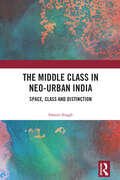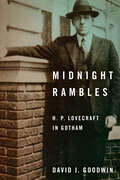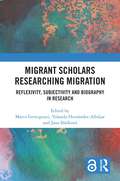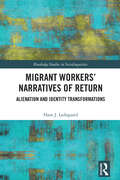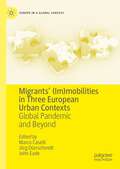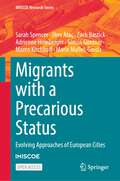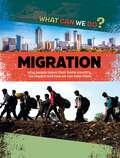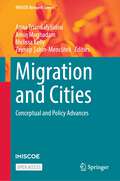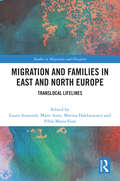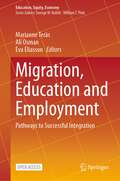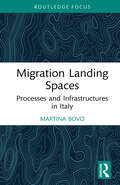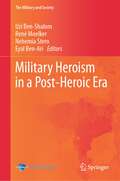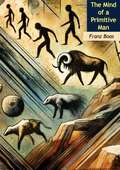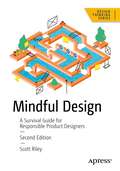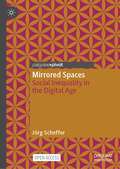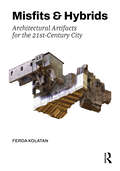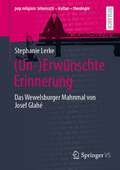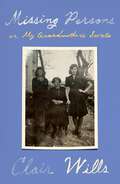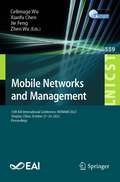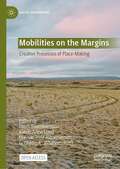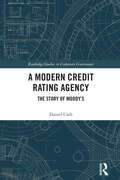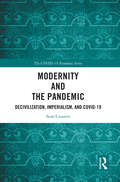- Table View
- List View
The Middle Class in Neo-Urban India: Space, Class and Distinction
by Smriti SinghThis book critically examines the new middle class and the emergence of neo-urban spaces in India within the context of rapid urbanisation and changing socio-spatial dynamics in urban areas in the country. It looks at class as a socio-spatial category where class distinction is tied to and manifests itself through the space of the city. With a detailed ethnographic study of the national capital region of Delhi, especially Gurugram, it explores themes such as class subjectivity, morality and social beliefs; life inside gated enclaves; family and everyday practices of class reproduction; and the process of othering and exclusivity, among others. Class identity, vulnerability and hierarchy influence the actions and motivations of the middle class. The author studies the nuances and socio-political fractures stemming from the complex dynamic of class, caste, religion and gender that manifest in these neo-urban spaces and how these shape the city and community. Rich in empirical resources, this book will be of interest to scholars and researchers of sociology, political sociology, ethnography, urban sociology, urban studies and South Asian studies.
Midnight Rambles: H. P. Lovecraft in Gotham
by David J. GoodwinA micro-biography of horror fiction’s most influential author and his love–hate relationship with New York City.By the end of his life and near financial ruin, pulp horror writer Howard Phillips Lovecraft resigned himself to the likelihood that his writing would be forgotten. Today, Lovecraft stands alongside J. R. R. Tolkien as the most influential genre writer of the twentieth century. His reputation as an unreformed racist and bigot, however, leaves readers to grapple with his legacy. Midnight Rambles explores Lovecraft’s time in New York City, a crucial yet often overlooked chapter in his life that shaped his literary career and the inextricable racism in his work. Initially, New York stood as a place of liberation for Lovecraft. During the brief period between 1924 and 1926 when he lived there, Lovecraft joined a creative community and experimented with bohemian living in the publishing and cultural capital of the United States. He also married fellow writer Sonia H. Greene, a Ukrainian-Jewish émigré in the fashion industry. However, cascading personal setbacks and his own professional ineptitude soured him on New York. As Lovecraft became more frustrated, his xenophobia and racism became more pronounced. New York’s large immigrant population and minority communities disgusted him, and this mindset soon became evident in his writing. Many of his stories from this era are infused with racial and ethnic stereotypes and nativist themes, most notably his overtly racist short story, “The Horror at Red Hook,” set in Red Hook, Brooklyn. His personal letters reveal an even darker bigotry.Author David J. Goodwin presents a chronological micro-biography of Lovecraft’s New York years, emphasizing Lovecraft’s exploration of the city environment, the greater metropolitan region, and other locales and how they molded him as a writer and as an individual. Drawing from primary sources (letters, memoirs, and published personal reflections) and secondary sources (biographies and scholarship), Midnight Rambles develops a portrait of a talented and troubled author and offers insights into his unsettling beliefs on race, ethnicity, and immigration.
Migrant Narratives: Storytelling as Agency, Belonging and Community (ISSN)
by Brigitte Bönisch-Brednich Anastasia Christou Silke Meyer Marie Johanna Karner Jakob Escher, Jakob EscherWith a focus on migrant narratives, or the storytelling about migration, this volume considers the ways in which migration is and has been shaped by individual and collective experiences of agency, belonging and community.Driven by an agenda of deep listening, each chapter presents a narrative directly derived from qualitative research, an outline of the methodological framing as well as narrative analysis. Through close attention to the narrative, its performative aspects and its ruptures and silences, authors identify patterns and material in the fabric of such telling and retelling of stories that open up new perspectives on the migrant experience. This book develops a methodology of "dwelling with stories" that allows for sustained and slow interrogation of the migrant experience and the accompanying decisions that shape narratives around mobility across borders. Its structure is innovative by emphasising the migrant voice and reflecting on the scholars’ positionality, while also offering new theoretical contributions that will advance the field of narrative analysis.The book will appeal to academics, students and practitioners in a wide range of subject areas within the humanities and social sciences, including anthropology, sociology, human geography, migration/refugee/diaspora studies and oral history.Chapter 5, 6, 7 and 8 of this book are freely available as a downloadable Open Access PDF at http://www.taylorfrancis.com under a Creative Commons [Attribution-Non Commercial-No Derivatives (CC-BY-NC-ND)] 4.0 license.
Migrant Scholars Researching Migration: Reflexivity, Subjectivity and Biography in Research
by Marco Gemignani Yolanda Hernández-Albújar Jana SládkováHow can biography and reflexivity become integral processes of an inquiry? How do we apply these processes to our research and to our accounts of ourselves? Presenting studies by migration scholars who are migrants themselves, Migrant Scholars Researching Migration illustrates the creative and affective function of embedding one's research in subjectivity, reflexivity, and personal biography. The book shows that linking personal experiences and biographies with research practices and agendas can be instrumental to the development of knowledges and new methodologies. The authors demonstrate, for instance, how their migration backgrounds have affected what kind of research they ‘should’ conduct. They also describe how their research findings have changed their understanding of their personal positionings as migrants and scholars. This book debunks the dogma of separating the researcher from their investigation by placing the researchers' experiences and multi-layered reflections at the center of their scholarly work. It sheds light on the importance of reflexivity and subjectivity as processes and assets in research rather than obstacles. Migrant Scholars Researching Migration will appeal to researchers and students interested in methodology, biographical research, theories of knowledge, and scholars of migration and diaspora studies. Chapters: Chapter 14 of this book is freely available as a downloadable Open Access PDF at http://www.taylorfrancis.com under a Creative Commons [Attribution-Non Commercial-No Derivatives (CC-BY-NC-ND)] 4.0 license.
Migrant Workers’ Narratives of Return: Alienation and Identity Transformations (Routledge Studies in Sociolinguistics)
by Hans J. LadegaardDrawing on a corpus of 113 narratives told by migrant workers who have returned to their home country, Ladegaard details Indonesian and Filipina (domestic) migrant workers’ experiences of homecoming after years of work abroad, separated from their loved ones. The narratives deal with two major themes: 1) Migrant workers’ experiences in the diaspora, which for many, particularly Indonesian workers, were associated with abuse and exploitation leading to trauma; and 2) migrant workers’ experiences of coming home, which include both the happy reunion with the family but also concerns about not ‘fitting in’ and the need to reinvent themselves because they are not who they were when they left. This is particularly true for workers whose migratory journeys have failed and who have come back to their hometowns without any financial award. Chapters also explore the major difference between Filipina and Indonesian migrant workers’ overseas experiences. The Filipina returnees share mostly positive stories while the Indonesian returnees uncover mostly negative stories, further illuminating what may explain these diverse migratory experiences. Finally, the book discusses how research on disenfranchised groups like (domestic) migrant workers can be used for social and political action. An excellent text that will appeal to academics, teachers and postgraduate students in the humanities and social sciences, particularly in sociolinguistics, applied linguistics, intercultural communication, anthropology, and migration studies.
Migrants’: Global Pandemic and Beyond (Europe in a Global Context)
by Marco Caselli Jörg Dürrschmidt John EadeThis book analyses the impact of the coronavirus pandemic on three ethnic minorities in three European cities: Bangladeshi in London, Turks in Stuttgart and Peruvians in Milan. Considerable debate has emerged during the pandemic concerning its impact on minorities, and although considerable quantitative data has been generated by epidemiologists, qualitative studies also have great relevance, socially and culturally as well as institutionally. While in normal circumstances the position of migrant communities is associated with unequal access to scarce resources such as wealth, power and social prestige, the coronavirus pandemic shifted the focus to more specific variables: living in segmented or overcrowded conditions, working in jobs with higher risk exposure, difficulties with online schooling, and lack of access to health care and information.The book will therefore be of interest to researchers and students of sociology, anthropology, global studies, migration and urban studies.
Migrants with a Precarious Status: Evolving Approaches of European Cities (IMISCOE Research Series)
by Sarah Spencer Ilker Ataç Zach Bastick Adrienne Homberger Simon Güntner Maren Kirchhoff Marie Mallet-GarciaThis open access book is an exploration of city responses to migrants with a precarious status in Europe. It provides new evidence and analysis from research on three cities in Austria, Germany and the UK: Vienna, Frankfurt and Cardiff. The book explores strategies and services of municipal authorities towards precarious migrants and their cooperation with non-governmental organisations (NGOs) in service provision. It focuses on healthcare, education, housing and access to advice; and particular attention is given to the situation of women.The book develops the concept of precarity in relation to migration status, and of horizontal governance arrangements within municipal authorities. It explores the tension between exclusion and inclusion of migrants who have limited rights of access to welfare services, and contributes evidence on the factors shaping municipal policy making, as well as on the framing of rationales for providing access to essential services.
Migration: What Can We Do? (What Can We Do? #5)
by Cath SenkerA look at one of the biggest challenges facing our world today - migration - and how we are tackling itPeople have always moved to find work, improve their lives or to escape conflict. Most stay in their own country, but some migrate to other lands. Migrants can bring host countries a range of benefits, from filling job vacancies to making cultures more diverse, but there are also undeniable challenges, and resources can feel very stretched.How can we build a better, fairer, more equal, cleaner world? This series seeks to answer this by exploring some of the greatest challenges facing our planet today - from disease to conflict, and from the energy crisis to the plight of refugees. It explains what is already being done to meet and tackle these challenges, and explores what more could and should be done, both individually and collectively, to ensure a better future for our planet, its people and its wildlife.Taking a positive, but realistic perspective, this series aims to empower young readers by helping them understand these complex and troubling issues, calm their anxieties, and promote empathy and understanding for the many millions of people suffering from for example, poverty or inequality.Perfect for readers aged 9 and upContents:What is migration?/Why do people migrate?/Who are migrants and where do they go?/Fleeing danger: refugees and IDPs/How moving is good for migrants/Difficulties for migrants/How migration helps host countries/Problems for host countries/Helping their homelands/Brain drain and dependence/Building peace/Climate-change action/The freedom of movement debate/Glossary/Further information/IndexTitles in the series:Climate ChangeDiseaseInequalityMigrationPoverty & Food InsecurityWar & Conflict
Migration and Cities: Conceptual and Policy Advances (IMISCOE Research Series)
by Melissa Kelly Anna Triandafyllidou Zeynep Şahin-Mencütek Amin MoghadamThis open access book brings together different perspectives on migration and the city that are usually discussed separately, to show the special character of the urban context as a territorial and political space where people coexist, whether by choice or necessity. Drawing on heterogeneous situations in cities in different world regions (including Europe, North America, the Middle East, South, Southeast and East Asia and the Asia Pacific) contributions to this volume examine how migration and the urban context interact in the twenty-first century. The book is structured in four parts. The first looks at cities as hubs of cultural creativity, exploring the many dimensions of cultural diversity and identity as they are negotiated in the urban context. The second focuses on what lies outside the large urban centres of today, notably suburbs, while the third part engages with migration and diversity in small and mid-sized cities, many of which have adopted strategies to welcome growing numbers of migrants. Last but not least, the fourth part looks at the challenges and opportunities that asylum-seeking and irregular migration flows bring to cities. By providing a variety of empirical cases based on various world regions, this book is a valuable resource for researchers, students and policy makers.
Migration and Families in East and North Europe: Translocal Lifelines (Studies in Migration and Diaspora)
by Laura Assmuth Marit Aure Marina Hakkarainen Pihla Maria SiimThis book explores the phenomenon of familyhood across borders, examining the experience of translocal familyhood and the manner in which lifelines in and between countries are formed when individual family members spend long periods away from home. Drawing on long-term ethnographic research, it considers the emotions, social relations, materialities and discourses that occur within family lives between Estonia, Finland, Latvia, Lithuania, Norway, Romania, Russia and Sweden. With attention to the ways in which gender, generation, class and geography create and reinforce inequalities, strengths and vulnerabilities within and between families, it combines ethnographic, descriptive work with shorter photography-based chapters in order to allow textual and visual methods to complement one another. As such, it will appeal to scholars of sociology, geography and anthropology with interests in migration, transnationalism and the sociology of the family.
Migration, Education and Employment: Pathways to Successful Integration (Education, Equity, Economy #10)
by Marianne Teräs Ali Osman Eva EliassonThis is an open access book which focuses on different aspects of education, employment, and successful integration of migrants in three countries: Norway, Sweden, and Switzerland. The chapters in this book reflect on these issues from micro, meso and macro perspectives; some are based on interviews with migrants and people who work with them, others on documents and literature about migration. There are different pathways for skilled migrants to vocations. Some start working in their previous vocations after arriving in the new environment. Some re-enter their professions but on a lower level. Some can re-train themselves in a new vocation, and some will go to further education, as studies in different chapters of this book suggest. Common for successful integration seems to be several intertwined factors: the target language competence, strong motivation and agency, supporting networks and supporting persons, as well as structural opportunities of the new environment. The book’s editorial board takes an eclectic view, hoping to start an academic debate about what ‘successful integration’ means. While discussions about the integration of migrants tend to focus on integration failures, there are millions of migrants, in different countries, who have successfully integrated into their new societies.
Migration Landing Spaces: Processes and Infrastructures in Italy (Routledge Studies in Development, Mobilities and Migration)
by Martina BovoThis book looks at migrant landing spaces, exploring the processes and infrastructures which people encounter as they navigate urban spaces along the central Mediterranean route.The book argues that there remains a theoretical and practical difficulty in grasping the complexity of migrant arrivals. Migrants are often unsure whether they will stay or leave, their mobility is uncertain. Despite this, they face rigid binaries and categories within administrative policy and planning which tries to pin them down as either permanent or temporary. Drawing on extensive original research in southern Italy, this book suggests that we should instead think of ‘landing spaces’: parts of the city that work as infrastructures for landing, that allow for an open and dynamic use of the urban space and provide opportunities for encounter and information exchange as migrants consider their next steps.Combining an ethnographic gaze with insights from urban planning, architecture, geography, social sciences and migration studies, this book invites us to look closer at the interactions between people, practices and places as migrants land in Europe.
Military Heroism in a Post-Heroic Era (The Military and Society)
by Uzi Ben-Shalom René Moelker Nehemia Stern Eyal Ben-AriThis book explores the variety of forms that individual heroism and sacrifice can take in the context of contemporary military conflicts. It addresses three key questions: How has an enduring ideal of heroism been transformed by the nature of modern warfare? Are we now witnessing the emergence of new forms of exemplary military behavior? And, have new ideals of heroism (and by association, sacrifice or bravery) been added to older forms in the recent past? The book advocates viewing the concept of military heroism as a moral category, in which its theoretical definition and empirical practice reflect those factors that are seen as being vital for society itself. The key theoretical and topical challenges addressed in the respective chapters focus on how ideas of heroism become entwined with issues of individualization (bolstered by the cultural assumptions of neo-Liberalism), the spread of the human rights discourse, and the judicialization, marketization and mediatization of armedforces. The book was written by experts on military studies, including many who are currently active military personnel. It includes contributions from a variety of disciplines, e.g. anthropology, sociology, psychology, and political science.
The Mind of a Primitive Man: Hereditary Characteristics, Linguistic and Cultural Traits of the Human Races
by Franz Boas“In this landmark text of anthropology, Franz Boas profiles various groups of primitive peoples, analyzing their hereditary characteristics, morphology, language and cultures.Brimming with incisive analysis and fascinating interpretations of early man, Boas begins by acknowledging the sheer diversity of peoples in the world. The variation in language, physical appearance, cultural mores and traditions are extraordinary, with differing behavioral standards and practices unique to each. Though dealing with a formidable subject of global scope, the author proceeds with determination and intellectual rigor, demonstrating how geographic disparity, variations in climate, and divergent psychology resulted in distinct cultures.Famous for challenging existing views, including those of eugenics and white supremacy, The Mind of Primitive Man became a foundational text of modern anthropologic science. Its well-argued topics, rooted in the author's voracious study and experience, contradicted existing theories and assumptions of nature versus nurture, and the relationship between environment and human intelligence. For his part, Boas held out hope that anthropology would form a role in education, increasing tolerance for the differences between cultures, and acknowledgement of the value all have contributed.”-Print ed.
Mindful Design: A Survival Guide for Responsible Product Designers (Design Thinking)
by Scott RileyLearn to create seamless designs backed by a responsible understanding of the human mind. This new edition is fully updated and reworked to employ a realistic, challenging, and practical approach to interface design, presenting state of the art scientific studies in behavioral sciences, interface design and the psychology of design. All with modern, up-to-date examples and screenshots. The practical portion of this edition has been completely reworked, giving you the chance to follow along with a real, proven design process that has produced several successful products imbued with the principles of mindful, responsible design.You'll examine how human behavior can be used to integrate your product design into lifestyle, rather than interrupt it, and make decisions for the good of those that are using your product. You will also learn about the neurological aspects and limitations of human vision and perception; about our attachment to harmony and dissonance; and about our brain’s propensity towards pattern recognition and how we perceive the world around us. In the second half of the book, you’ll follow along with the key phases of a design project, implementing what you have learned in an end-to-end, practical setting. Design is a responsibility, but not enough designers understand the human mind or the process of thought. Mindful Design, Second Edition introduces the areas of brain science that matter to designers, and passionately explains how those areas affect each human’s day-to-day experiences with products and interfaces, providing a battle-tested toolkit to help you make responsible design decisions. What You'll Learn Review how attention and distraction work and the cost of attentional switchingUse Gestalt principles to communicate visual groupingEnsure your underlying models make sense to your audienceUse time, progression, and transition to create a compositionCarefully examine controlling behavior through reductionist and behaviorist motivation concepts Apply the theoretical knowledge to practical, mindful interface design Who This Book Is For The primary audience for this book is professional designers who wish to learn more about the human mind and how to apply that to their work. The book is also useful for design-focused product owners and startup founders who wish to apply ethical thinking to a team, or when bootstrapping their products. The secondary audience is design students who are either studying a ‘traditional’ visual design course, or a UX/interaction design course who have a desire to learn how they might be able to apply mindful design to their early careers. Finally, a tertiary audience for this book would be tutors involved in teaching design, or peripheral, courses who may wish to incorporate its teachings into their lectures, workshops or seminars.
Mirrored Spaces: Social Inequality in the Digital Age (Geographies of Media)
by Jörg SchefferThis open access book critically examines discussions on digitalisation and individual opportunities for socio-economic advancement. Contrary to the prevailing narratives of “digital empowerment” and opportunities for every individual, this book argues that digitalisation massively curtails social advancement opportunities, consolidating existing social relations. From a spatial perspective, Scheffer demonstrates how socially disadvantaged groups are faced with reproducing mechanisms as part of a new data economy. Surprisingly, the more intensively digital services are used, the more this happens.Building on Löw´s sociology of space and Bourdieu´s concept of habitus, this book shows how practices of social exclusion are transferred to the digital present in an innovative way. The image of “mirrored” spaces describes a new mechanism that explains social exclusion in the age of digitalisation. This book is an essential resource for researchers and students interested in socio-economic inequalities, processes of digitalisation, and digital geographies.
Misfits & Hybrids: Architectural Artifacts for the 21st-Century City
by Ferda KolatanContemporary cities are shaped by the unlikely adjacencies of objects that are vastly different in kind, origin, and scale: buildings, infrastructure, and other urban components that over time accumulate into mismatched configurations. However, despite the ubiquity of these oddities and their impact on the city, we rarely give them much consideration. In Misfits & Hybrids, Ferda Kolatan explores the untapped potential in these unexpected conditions for a new kind of architecture. A diverse array of projects, developed in Kolatan’s design studios at the University of Pennsylvania Weitzman School of Design, illustrates how hybrid artifacts can reveal the often overlooked cultural, socio-political, and material histories of a site, fostering design tactics invested in reinventing the existing. Set within the cosmopolitan megacities of Istanbul, Cairo, and New York, the projects are conceived as real fictions, conjuring novel narrative, aesthetic, and representational forms to reflect the pluralistic postindustrial city.
**Missing**: Das Wewelsburger Mahnmal von Josef Glahé (pop.religion: lebensstil – kultur – theologie)
by Stephanie LerkeAngesichts des Verstummens von Zeitzeug:innen und des Wiedererstarkens fremdenfeindlicher Motive und Mechanismen wie Antisemitismus, Rassismus und Rechtspopulismus ist Erinnerung an den Holocaust aktueller denn je. Gedenkstätten wie die „Erinnerungs- und Gedenkstätte Wewelsburg 1933 – 1945“ nahe Paderborn stellen in der gesellschaftlichen Erinnerungskultur als bildungspolitische Orte zur Erinnerung an die Opfer des Nationalsozialismus und der Mahnung an die leidvollen Ereignisse unter der nationalsozialistischen Diktatur eine notwendige Möglichkeit hierfür dar. Um sich mit dieser politisch sensiblen Geschichte und ihren aktuellen Erscheinungsformen auseinanderzusetzen, bedient sich die Wewelsburg des Ausdrucksmittels Kunst. Als erste umfassende interdisziplinäre Grundlagenforschung befasst sich dieses Buch mit jenem einzigartigen Stück bundesdeutscher Kunstgeschichte nach 1945, einer bildgewordenen, (un-)erwünschten Erinnerung aus einer theologischen Perspektive. Stephanie Lerke zeigt auf, dass das nachkriegsexpressionistische Wewelsburger Mahnmal von Josef Glahé den Betrachtenden durch sein breites Bildprogramm ein komplexes Themenfeld von historischen und theologischen Inhalten mit aktueller, erinnerungspolitischer Relevanz eröffnet. Sie verdeutlicht, wie dieses „zeitlose“ Medium mit seiner Fülle an Interpretationsspielräumen und Gegenwartsbezügen zur individuellen Spurensuche und Auseinandersetzung mit lebendiger Geschichte einlädt.
Missing Persons: or, My Grandmother's Secrets
by Clair WillsBlending memoir with social history, Clair Wills movingly explores the holes in the fabric of modern Ireland, and in her own family story."Clair Wills shines a brilliant, unsparing light into the dark recesses of her family’s history—and the history of Ireland. Missing Persons is a stunningly eloquent exploration of how truth-telling, secret-keeping, and outright lies are part of all family stories—indeed, the stories that unite all communities—and how truths, secrets and lies can both protect and destroy us." —Jeannette Walls, author of The Glass Castle and Hang the MoonWhen Clair Wills was in her twenties, she discovered she had a cousin she had never met. Born in a mother-and-baby home in 1950s Ireland, Mary grew up in an institution not far from the farm where Clair spent happy childhood summers. Yet Clair was never told of Mary’s existence. How could a whole family—a whole country—abandon unmarried mothers and their children, erasing them from history?To discover the missing pieces of her family’s story, Clair searched across archives and nations, in a journey that would take her from the 1890s to the 1980s, from West Cork to rural Suffolk and Massachusetts, from absent fathers to the grief of a lost child.There are some experiences that do not want to be remembered. What began as an effort to piece together the facts became an act of decoding the most unreliable of evidence—stories, secrets, silences. The result is a moving, exquisitely told account of the secrets families keep, and the violence carried out in their name.
Mobile Networks and Management: 13th EAI International Conference, MONAMI 2023, Yingtan, China, October 27-29, 2023, Proceedings (Lecture Notes of the Institute for Computer Sciences, Social Informatics and Telecommunications Engineering #559)
by Celimuge Wu Xianfu Chen Jie Feng Zhen WuThis book constitutes the refereed post-conference proceedings of the 13th International Conference on Mobile Networks and Management, MONAMI 2023, held in Yingtan, China, in October 2023. The 21 full papers were carefully reviewed and selected from 41 submissions. The papers are divided into groups of content as follows: Wireless Communication and Networks; Network Security and Blockchain; Image Processing and Computer Vision; Distributed Computing; Emerging Applications.
Mobilities in Remote Places (Changing Mobilities)
by Phillip VanniniMobilities in Remote Places explores the meanings, challenges, and opportunities of remoteness as practiced and experienced by those who live and work in some of the world’s most remote communities. As mobilities around the world proliferate in countless forms, the meanings of remoteness undergo significant change. Places once considered impossibly distant have appeared to become closer, more accessible, and less distinct from global centres of geopolitical power. But instead of disappearing altogether, configurations of remoteness evolve, manifesting themselves through new possibilities, new challenges, and new insecurities. Drawing from a variety of case studies from around the globe, the book’s contributors examine remoteness as an outcome of evolving mobility constellations. Rather that defining remoteness as an absolute or objective time-distance condition, the book shows how remoteness is a practice, experience, and representation that is situated, relational, and emergent. This collection of original and thought-provoking chapters will be of interest to students and researchers in the humanities and social sciences with an interest in mobilities, place, and human geography.
Mobilities on the Margins: Creative Processes of Place-Making (Arctic Encounters)
by Björn Thorsteinsson Katrín Anna Lund Gunnar Thór Jóhannesson Guðbjörg R. JóhannesdóttirThis open access book examines places on the margins and the dynamics through which a marginal position of a place is created. Specifically, it explores how places, mostly in sparsely populated areas, often perceived as immobile and frozen in time, come into being and develop through interference of everyday mobilities and creative practices that cut across the spheres of culture and nature as usually defined. Through fieldwork and case studies from areas in Iceland, Finland, Greenland, and Scotland, the book’s twelve chapters draw out the multiple relations through which places emerge, where people compose their lives as best they can with their surroundings. A special concern is to explore the links between travelling, landscape, and material culture and how places and margins are enacted through mobilities and creative practices of humans and other beings. The emphasis on mobility disturbs the perception of a place as a bounded entity and offers a useful and necessary understanding of places as mobile and fluid. Mobilities on the Margins is a novel and timely contribution to the exploration of human and more-than-human interactions in a world of increasingly fluid mobilities and insistent crises.
A Modern Credit Rating Agency: The Story of Moody’s (Routledge Studies in Corporate Governance)
by Daniel CashThis book aims to present a picture of one of the world’s leading credit rating agencies. Credited as being the first credit rating agency, Moody’s stands as the epitome of the rating sector and all that it effects. However, outside of internal and non-public histories compiled within the rating agency itself, the story of Moody’s has never been told, until now. However, this is not a historical book. Rather, this book paints a picture of Moody’s on a wider canvas that introduces the concept of rating to you, taking into account the origins of the sector, the competitive battles that formed the modern-day oligopoly, and the characters that have each taken their turn on sculpting the industry that, today, is critical to the modern economy. The book is a story of personable people who provided the market with what it needed, but it is more than that. It is a story of conflict, impact, strategy, and most of all the relationship between big business and modern society. Standing as the gatekeeper to the capital markets that form the core of modern society, Moody’s represents the very best of what the marketplace can produce, but also the very worst. This story takes in economic crises in the antebellum US, the Panics of the early 1900s, the Wall Street Crash and the Great Depression and, of course, the Global Financial Crisis. It does this because, at the heart of each one was a member of the rating industry or the reporting industry that preceded it. Associated with almost any financial scandal you may care to remember the credit rating agencies, in their often-uncomfortable role as gatekeepers, have their fingerprints on most financial scandals and calamities. This book tells the story of the industry’s founding member.
A Modern Credit Rating Agency: The Story of Moody’s (Routledge Studies in Corporate Governance)
by Daniel CashThis book aims to present a picture of one of the world’s leading credit rating agencies. Credited as being the first credit rating agency, Moody’s stands as the epitome of the rating sector and all that it effects. However, outside of internal and non-public histories compiled within the rating agency itself, the story of Moody’s has never been told, until now. However, this is not a historical book. Rather, this book paints a picture of Moody’s on a wider canvas that introduces the concept of rating to you, taking into account the origins of the sector, the competitive battles that formed the modern-day oligopoly, and the characters that have each taken their turn on sculpting the industry that, today, is critical to the modern economy.The book is a story of personable people who provided the market with what it needed, but it is more than that. It is a story of conflict, impact, strategy, and most of all the relationship between big business and modern society. Standing as the gatekeeper to the capital markets that form the core of modern society, Moody’s represents the very best of what the marketplace can produce, but also the very worst. This story takes in economic crises in the antebellum US, the Panics of the early 1900s, the Wall Street Crash and the Great Depression and, of course, the Global Financial Crisis. It does this because, at the heart of each one was a member of the rating industry or the reporting industry that preceded it. Associated with almost any financial scandal you may care to remember the credit rating agencies, in their often-uncomfortable role as gatekeepers, have their fingerprints on most financial scandals and calamities. This book tells the story of the industry’s founding member.
Modernity and the Pandemic: Decivilization, Imperialism, and COVID-19 (The COVID-19 Pandemic Series)
by Sean CreavenModernity and the Pandemic: Decivilization, Imperialism, and COVID-19 applies the tools of critical social theory to make sense of the COVID-19 crisis and presents a critical sociological analysis of aspects of the political and community response to the pandemic. The book focuses on key themes integral to a sociology of pandemics in the ‘global’ age. Firstly, Creaven argues that cultures of individualism and consumerism, and of pervasive and deeply entrenched social inequalities (i.e. decivilization) significantly weaken the cause of public health by weakening the compliance of people with state-mandated non-pharmaceutical interventions (including and especially physical distancing rules) and encouraging vaccine hesitancy. Secondly, Creaven examines how interstate competition and imperial politics has undermined an effective global policy response to the COVID-19 pandemic. Policy failure with regard to the management of the pandemic is interpreted as being rooted in the dominance of neoliberal ideology and governance in the politics of international relations, particularly in the politics of the leading state actors, by protection of corporate interests at the expense of public health, and in the constraints imposed on state actors by the competitive dynamic of multinational capitalism in the ‘global’ age. Modernity and the Pandemic will appeal to scholars in the humanities and social sciences with interests in neoliberalism and its social, cultural and epidemiological impacts.
